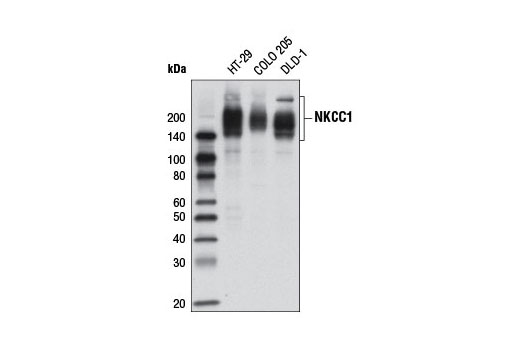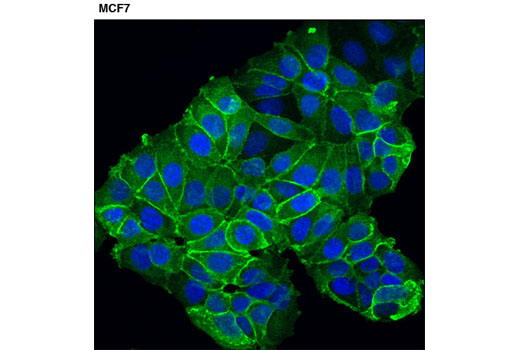WB, IP, IF-IC
H
Endogenous
160-200
Rabbit IgG
#P55011
6558
Product Information
Product Usage Information
| Application | Dilution |
|---|---|
| Western Blotting | 1:2000 |
| Immunoprecipitation | 1:50 |
| Immunofluorescence (Immunocytochemistry) | 1:100 |
Storage
Specificity / Sensitivity
Species Reactivity:
Human
Species predicted to react based on 100% sequence homology
The antigen sequence used to produce this antibody shares
100% sequence homology with the species listed here, but
reactivity has not been tested or confirmed to work by CST.
Use of this product with these species is not covered under
our
Product Performance Guarantee.
Bovine, Pig
Source / Purification
Monoclonal antibody is produced by immunizing animals with a synthetic peptide corresponding to residues surrounding Arg80 of human NKCC1 protein.
Background
The electroneutral cation-chloride-coupled co-transporter (SLC12) gene family comprises bumetanide-sensitive Na+/K+/Cl- (NKCC), thiazide-sensitive Na+/Cl-, and K+/Cl- (KCC) co-transporters. SLC12A1/NKCC2 and SLC12A2/NKCC1 regulate cell volume and maintain cellular homeostasis in response to osmotic and oxidative stress (1). The broadly expressed NKCC1 is thought to play roles in fluid secretion (i.e. salivary gland function), salt balance (i.e. maintenance of renin and aldosterone levels), and neuronal development and signaling (2-7). During neuronal development, NKCC1 and KCC2 maintain a fine balance between chloride influx (NKCC1) and efflux (KCC2), which regulates γ-aminobutyric acid (GABA)-mediated neurotransmission (3). Increased NKCC1 expression in immature neurons maintains high intracellular chloride levels that result in inhibitory GABAergic signaling; KCC2 maintains low intracellular chloride levels and excitatory GABAergic responses in mature neurons (4,5,8). Deletion of NKCC1 impairs NGF-mediated neurite outgrowth in PC-12D cells while inhibition of NKCC1 with bumetanide inhibits re-growth of axotomized dorsal root ganglion cells (6,7). Defective chloride homeostasis in neurons is linked to seizure disorders that are ameliorated by butemanide treatment, indicating that abnormal NKCC1 and NKCC2 expression or signaling may play a role in neonatal and adult seizures (9-12). NKCC1 is found as a homodimer or within heterooligomers with other SLC12 family members. This transport protein associates with a number of oxidative- and osmotic-responsive kinases that bind, phosphorylate, and activate NKCC1 co-transporter activity (13-16). In response to decreased intracellular chloride concentrations, Ste20-related proline-alanine-rich kinase (SPAK) phosphorylates NKCC1 to increase co-transporter activity and promote chloride influx (16-19). Oxidative stress response kinase 1 (OSR1) also phosphorylates and activates NKCC1 in response to oxidative stress (14).
- Hebert, S.C. et al. (2004) Pflugers Arch 447, 580-93.
- Evans, R.L. et al. (2000) J Biol Chem 275, 26720-6.
- Kim, S.M. et al. (2008) Am J Physiol Renal Physiol 295, F1230-8.
- Khirug, S. et al. (2008) J Neurosci 28, 4635-9.
- Kahle, K.T. et al. (2008) Nat Clin Pract Neurol 4, 490-503.
- Nakajima, K. et al. (2007) Biochem Biophys Res Commun 359, 604-10.
- Pieraut, S. et al. (2007) J Neurosci 27, 6751-9.
- Ben-Ari, Y. (2002) Nat Rev Neurosci 3, 728-39.
- Fukuda, A. (2005) Nat Med 11, 1153-4.
- Dzhala, V.I. et al. (2005) Nat Med 11, 1205-13.
- Jayakumar, A.R. et al. (2008) J Biol Chem 283, 33874-82.
- Kahle, K.T. and Staley, K.J. (2008) Neurosurg Focus 25, E22.
- Moore-Hoon, M.L. and Turner, R.J. (2000) Biochemistry 39, 3718-24.
- Simard, C.F. et al. (2007) J Biol Chem 282, 18083-93.
- Piechotta, K. et al. (2002) J Biol Chem 277, 50812-9.
- Dowd, B.F. and Forbush, B. (2003) J Biol Chem 278, 27347-53.
- Geng, Y. et al. (2009) J Biol Chem 284, 14020-8.
- Smith, L. et al. (2008) J Biol Chem 283, 22147-56.
- Gagnon, K.B. et al. (2006) Mol Cell Biol 26, 689-98.
Species Reactivity
Species reactivity is determined by testing in at least one approved application (e.g., western blot).
Western Blot Buffer
IMPORTANT: For western blots, incubate membrane with diluted primary antibody in 5% w/v nonfat dry milk, 1X TBS, 0.1% Tween® 20 at 4°C with gentle shaking, overnight.
Applications Key
WB: Western Blotting IP: Immunoprecipitation IF-IC: Immunofluorescence (Immunocytochemistry)
Cross-Reactivity Key
H: human M: mouse R: rat Hm: hamster Mk: monkey Vir: virus Mi: mink C: chicken Dm: D. melanogaster X: Xenopus Z: zebrafish B: bovine Dg: dog Pg: pig Sc: S. cerevisiae Ce: C. elegans Hr: horse GP: Guinea Pig Rab: rabbit All: all species expected
Trademarks and Patents
Limited Uses
Except as otherwise expressly agreed in a writing signed by a legally authorized representative of CST, the following terms apply to Products provided by CST, its affiliates or its distributors. Any Customer's terms and conditions that are in addition to, or different from, those contained herein, unless separately accepted in writing by a legally authorized representative of CST, are rejected and are of no force or effect.
Products are labeled with For Research Use Only or a similar labeling statement and have not been approved, cleared, or licensed by the FDA or other regulatory foreign or domestic entity, for any purpose. Customer shall not use any Product for any diagnostic or therapeutic purpose, or otherwise in any manner that conflicts with its labeling statement. Products sold or licensed by CST are provided for Customer as the end-user and solely for research and development uses. Any use of Product for diagnostic, prophylactic or therapeutic purposes, or any purchase of Product for resale (alone or as a component) or other commercial purpose, requires a separate license from CST. Customer shall (a) not sell, license, loan, donate or otherwise transfer or make available any Product to any third party, whether alone or in combination with other materials, or use the Products to manufacture any commercial products, (b) not copy, modify, reverse engineer, decompile, disassemble or otherwise attempt to discover the underlying structure or technology of the Products, or use the Products for the purpose of developing any products or services that would compete with CST products or services, (c) not alter or remove from the Products any trademarks, trade names, logos, patent or copyright notices or markings, (d) use the Products solely in accordance with CST Product Terms of Sale and any applicable documentation, and (e) comply with any license, terms of service or similar agreement with respect to any third party products or services used by Customer in connection with the Products.


